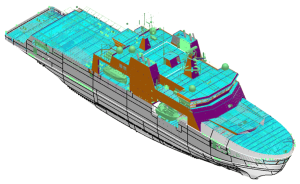The federal government has reached an agreement with Irving Shipbuilding to build six Arctic Offshore Patrol Ships (AOPS), otherwise known as the Harry DeWolf class.
The $2.3 billion contract was announced in Ottawa by senior officials and Kevin McCoy, president of the Halifax shipyard.
Under a design-then-build approach, Irving will begin initial test modules in June followed by full construction of the first ship in September. Irving has been working with the design since 2012 and has been “maturing” it through multiple reviews, a senior official said, in order to reduce risk associated with costly design changes. The shipyard is now completing the design process as it moves to a “build ready state.”
The ships will be constructed from three mega blocks comprised of 62 building blocks and will be assembled on Irving’s new land level facility, part of a more than $300 million modernization of the yard that had to be completed before a build contract could be finalized.
The approach of a completed design before construction “maximizes production efficiency, and reduces overall program risk,” McCoy.
Government officials said negotiation had been ongoing for the past 14 months to “ensure an innovative, incentive-based build contract.” Though the deal calls for six ships, it guarantees five for the same ceiling price if there are any unforeseen costs. However, it is “in Irving’s best interest to keep costs down [and build all six ships] so as to receive an increased fee based on a negotiated incentivized fee structure,” a senior official said.
Because the “AOPS is a new design and a new class of ship being built in a brand new shipyard [and] these factors bring risks with them,” the government increased the overall project budget from $3.1 billion to $3.5 billion to cover contingencies, such as potential fluctuations in exchange rates, inflation and labour costs. The lack of sufficient allowance for contingencies was flagged by the Auditor General in a recent report.
“The challenge is to find the appropriate balance between risk and cost certainty,” a senior official said.
According to the Royal Canadian Navy, the review process “did resulted in some changes to the ship design, none of which resulted in the elimination of major capability or effected the ability to meet all operational requirements.” Changes included lengthening the ship to make it simpler to produce, and simplification of some of its systems.
The first ship is expected to roll off the slip in 2018, followed by one roughly ever nine months.
